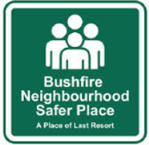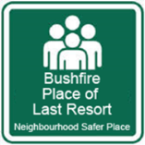A 'Neighbourhood Safer Place' (also known as a 'Bushfire Place of Last Resort' or NSP-BPLR) is a place of last resort when all other bushfire plans have failed.


What are NSP-BPLRs?
- Locations that may provide some protection from direct flame and heat from a fire, but they do not guarantee safety.
- Not an alternative to planning to leave early or to stay and defend your property; they are a place of last resort if all other fire plans have failed.
- An existing location and not a purpose-built, fire-proof structure. It is important to know that many NSP-BPLRs are simply a clearing that provides separation distance from the bushfire hazard (e.g. forest).
- Not to be confused with Community Fire Refuges, Relief Centres, Recovery Centres or Assembly Areas, each of which have a different and specific purpose.
- Not an appropriate destination when leaving the area early.
- Not a place of shelter from other types of emergencies (e.g. to escape rising floodwaters or severe weather events).
Where are NSP-BPLRs?
- An NSP-BPLR may be an open space at a local sports field, foreshore or park, or they may be located within a community building such as a hall or sports pavilion.
- You can recognise an NSP-BPLR by a green and white sign which includes the words;
- 'Bushfire Neighbourhood Safer Place - A Place of Last Resort' or
- 'Bushfire Place of Last Resort – Neighbourhood Safer Place'
- NSP-BPLRs are established by local government. Not all townships have a designated NSP-BPLR in the local area.
Search CFA Local to find your nearest NSP-BPLR
Please visit the 'Local Information' page regularly to ensure that you have knowledge of the current designated NSP-BPLRs near you. It is important to understand that locations are added and removed by municipal councils from time to time. Please ensure you read the important information on this page before you search for NSP-BPLRs.
Will I be safe at an NSP-BPLR?
- Sheltering at an NSP-BPLR does not guarantee your safety. An NSP-BPLR may offer improved protection (e.g. a safer place) if caught in a fire but they cannot be considered as 'safe'.
- Travelling to and using a place of last resort is dangerous and can lead to mental trauma, serious injury or death. Traffic congestion, fire activity, accidents or fallen trees may block the route.
- CFA or other emergency services may not be present at an NSP-BPLR.
- NSP-BPLRs may not have the capacity to cater for special needs (e.g. infants, elderly, ill or disabled).
- There will be no support services (e.g. food or drinks, medical services) and no provision for pets or livestock.
- NSP-BPLRs may not provide shelter from the elements. People sheltering at an NSP-BPLR are likely to experience extreme conditions such as heat, high winds, fire noise, and exposure to flying embers; and may experience breathing difficulties due to smoke and ash.
- On Extreme and Catastrophic Fire Danger Rating days, the temperature is likely to be more than 35°C and the heat and sun will impact on those who shelter at an NSP-BPLR.
- Visibility is likely to be extremely poor due to smoke.
- NSP-BPLRs are places of absolute last resort. The safest place to be is out of a high-risk bushfire area.
What are the things to consider if I decide to shelter at an NSP-BPLR?
- If an NSP-BPLR becomes your last resort option, it is very important that you wear protective clothing and take essentials such as drinking water, medication and mobile phone.
- Ensure you are confident that the travel path is open and safe at this time. Fire activity, thick smoke and ash can make it disorientating and difficult to see. Even well-known travel routes may be difficult to navigate in these conditions.
- You must continue to monitor conditions while you shelter at an NSP-BPLR by being aware of your surroundings and, if possible using a radio or mobile phone. Be aware that communications such as mobile phones and internet may be down during a fire.
- You may need to actively defend your NSP-BPLR against the effects of bushfire such as putting out spot fires from embers.
What do I do if it is too late to safely reach the NSP-BPLR or there is no NSP-BPLR in my area?
- The key is planning ahead. Read the CFAs 'Fire Ready Kit' to help you understand your risk and prepare your household's bushfire plan. Everyone should have a Bushfire Plan and should practise it.
- It is also critical that people living in high bushfire risk areas have a backup plan should their primary Bushfire Plan fail.
- A back up plan may include a nearby NSP-BPLR but should also identify other last resort options that individuals have personally assessed as being a safer option if caught in a fire. Find out more about back up plans and other last resort options.
How are NSP-BPLRs designated?
- Councils identify, designate and maintain NSP-BPLRs.
- Councils request CFA to assess a potential NSP-BPLR against their Neighbourhood Safer Places - Assessment Guidelines (PDF 550.5KB)
- If the site meets with CFA's radiant heat assessment criteria, council then assess the site against other criteria outlined in a Municipal Neighbourhood Safer Places Plan, including access and exit, vegetation clearance, traffic management and other uses of the site.
- Agreements with landowners must also be negotiated in some cases.
- You can view a complete list of designated NSP-BPLRs state-wide (PDF 402.9KB). This list will be updated as sites are added or removed by councils. Search CFA Local to find your nearest NSP-BPLRs displayed on a list and map.
What does leave early mean?
- On hot, dry, windy days, especially on Catastrophic Fire Danger Rating days, leaving the area early before there is any chance of fire activity, including along your travel path, is always the safest option.
- Children, the elderly, people with respiratory or cardiovascular illness, or those with special needs should be well away from the threat, where possible.
- People should not plan to defend a property on Catastrophic days. Most homes are not designed or constructed to withstand fire in Catastrophic conditions, and such days may make even well-prepared and resourced properties undefendable.
- You should not wait and see what happens during a bushfire – Leaving late means you will be on the road when conditions are at their worst. Driving during a bushfire is extremely dangerous and can be fatal.
What if I live near the Victoria / New South Wales or Victoria / South Australia borders?
See Neighbourhood Safer Places in New South Wales or Bushfire Safer Places in South Australia
Page last updated: Thursday, 19 June 2025 11:57:01 AM